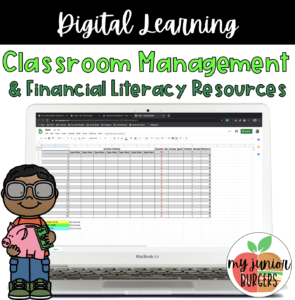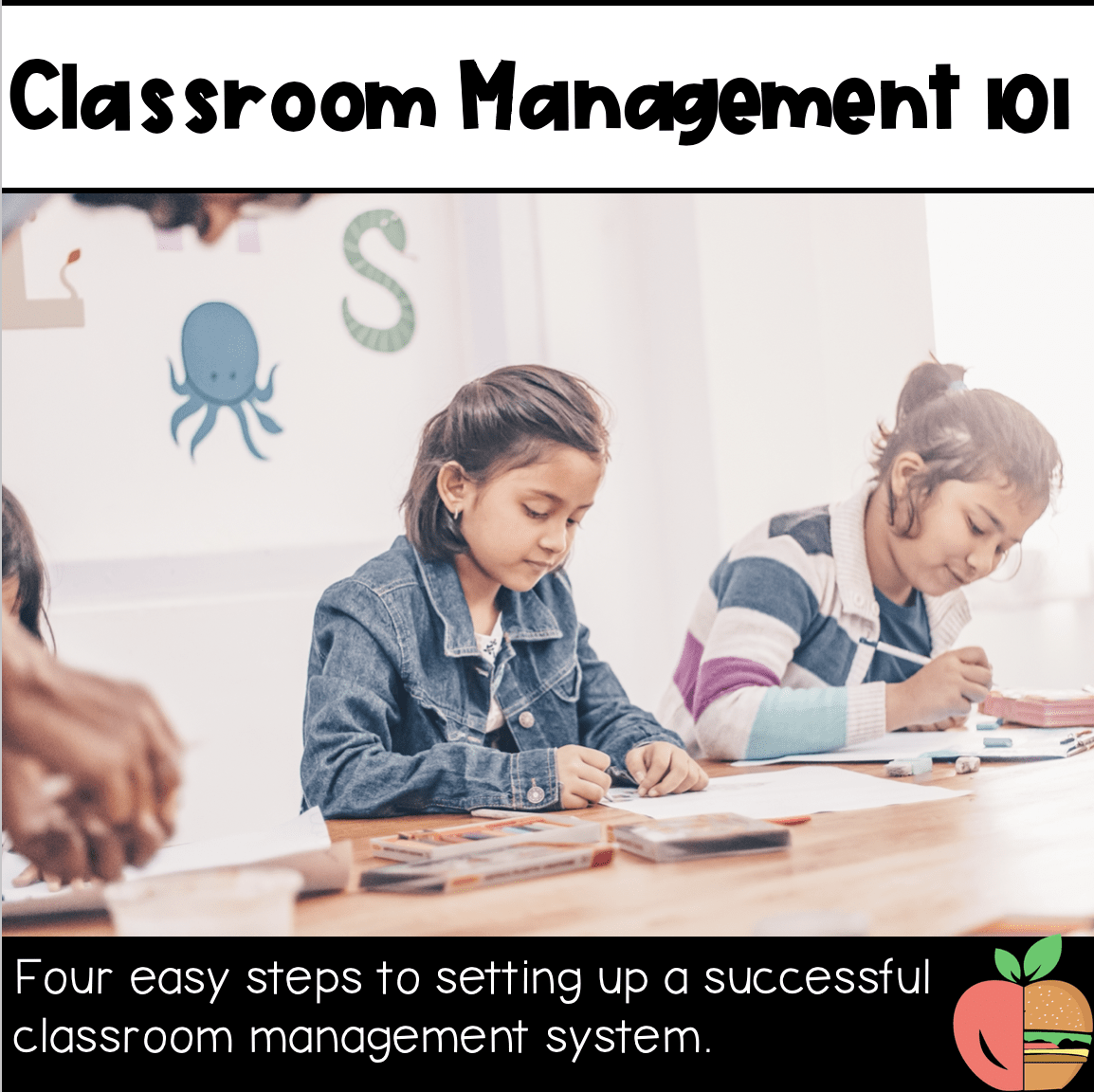Four easy steps to setting up a successful classroom management system.
Classroom management is the most crucial part of a well-oiled learning machine, but why is it so hard to master? You’re throwing 20 or more little bodies from 20 or more different backgrounds with different parents, home lives, and experiences all in one room! Of course there are going to be challenges! But with some preparation, you can have a more calm, nurturing environment in no time!
Set your classroom up for success
The layout and seating chart in your classroom makes a huge difference! I’ve taught in both primary and intermediate and those two layouts are going to be vastly different based on curriculum and classroom size.
 Set up your classroom in a way that makes the most sense for you! I always start with my teacher table because I want to be able to see every child from my yoga ball seat while I am working with a small group. If you plan to use a “circle time” area, make sure you have the space for it. Decide if you like tables or desks better. Think about if flexible seating is something you think will work well for your teaching style. I used some flexible seating in kindergarten but my fourth grade class is entirely made up of flexible seating.
Set up your classroom in a way that makes the most sense for you! I always start with my teacher table because I want to be able to see every child from my yoga ball seat while I am working with a small group. If you plan to use a “circle time” area, make sure you have the space for it. Decide if you like tables or desks better. Think about if flexible seating is something you think will work well for your teaching style. I used some flexible seating in kindergarten but my fourth grade class is entirely made up of flexible seating.
Think purposefully about what you will put on each bulletin board. Personally, I always dedicate at least one board to celebrating student work, one board to some type of academic or behavioral goal, and I use any remaining boards for my school’s requirements of posting standards and goals.
Have a place in mind for any behavior management materials. I put my rules front and center directly beneath my board where the children can see them from virtually any point in the room because I want them to be a constant reminder of my expectations!
Have a plan in place
Before you first day of school, think of your classroom rules. It is a good idea in elementary to have no more than 5. These are mine:
We are kind.
We follow directions.
We make safe choices.
We try our best.
These 4 rules cover every possible scenario and have worked well for me in primary and intermediate! Depending on your school environment and teaching style, you may want to tweak them here or there, but simple and clear is best when working with children!
Next, you will want to make a plan for how you will handle behaviors. Think out both individual and whole group behavior plans. For example, when I taught kin dergarten, I had a color chart for individual behaviors. The children all started in the middle every day and could go up or down based on their choices. It was an easy way for each individual child to visually track his or her progress! In fourth grade, I use a digital “banking” system that you can get here. It’s a more mature way for the kiddos to see how they are doing.
dergarten, I had a color chart for individual behaviors. The children all started in the middle every day and could go up or down based on their choices. It was an easy way for each individual child to visually track his or her progress! In fourth grade, I use a digital “banking” system that you can get here. It’s a more mature way for the kiddos to see how they are doing.
As a class, in all grade levels, my kiddos have earned marbles or pom pom jars. Each time they got a compliment as a class from another teacher, they got to put an object in our jar. When they filled their compliment jar, they got a class reward, like a pajama day or no shoes in the classroom. You wouldn’t believe how excited kids of all ages are to walk around in their socks!
To download my free behavior tracking and cool down spot materials click here!
It’s always a good idea to collaborate with teammates so everyone is on the same page, especially if you are departmentalized! One little trick you can do as a team is have a desginated colored folder as a “cool down” folder. Every time a child goes to another teacher with that colored folder, that team member knows that the child simply needed a break.
You will also want to consider basic needs like how you expect students to ask to go to the restroom or get water. What will you do to get your class’s attention? How will students be expected to transition? These are all things that can make or break a smooth day in your classroom!
Know your kids
I can’t begin to tell you how often one of my college professors said this to us and after I first started teaching, I totally understood why! Each classroom has such a  range of behaviors, even the best laid plans can go awry if you don’t know your students. Every class I have ever had included some children that didn’t need any motivation whatsoever, a majority of children that did consistently well with the established plan, with minor behaviors here and there, and still others that my principal calls “naught pickles” that need additional motivation on top of the general plan.
range of behaviors, even the best laid plans can go awry if you don’t know your students. Every class I have ever had included some children that didn’t need any motivation whatsoever, a majority of children that did consistently well with the established plan, with minor behaviors here and there, and still others that my principal calls “naught pickles” that need additional motivation on top of the general plan.
After setting up clear expectations for every child at the beginning of the year, find what works for each student and which children need an extra push. If you work in upper grades, asking the child’s former teacher is a great way to get the “411” on Billy John Joe!
Be consistent
And finally, be consistent! If you tell your primary students that if they touch a friend, they will get a warning and then they will have to go to timeout, or what I call “refocus time” for 5 minutes, follow through!

If Billy John keeps poking Anna May next to him, and you continue to give warnings without putting him in refocus, all he has learned is he can get away with poking Anna May without consequences. What we want him to learn is that it is okay to make a mistake occasionally, but after that, you expect him to improve his behavior or there will be consequences to his actions.
On the other hand, we also want the children to be aware that there are good consequences to their actions! Whether you do a treasure box or class store, allowing the children to use their rewards consistently, such as every Friday, teaches them that good choices lead to good rewards!
For any and all of my behavior strategies with attention songs, chants, behavior charts, behavior data tracking and more… click here to see my Behavior Management Kit on TpT!
And contact me @MyJunior Burgers to tell me your favorite classroom management tips and tricks!
-Ms. Burger

